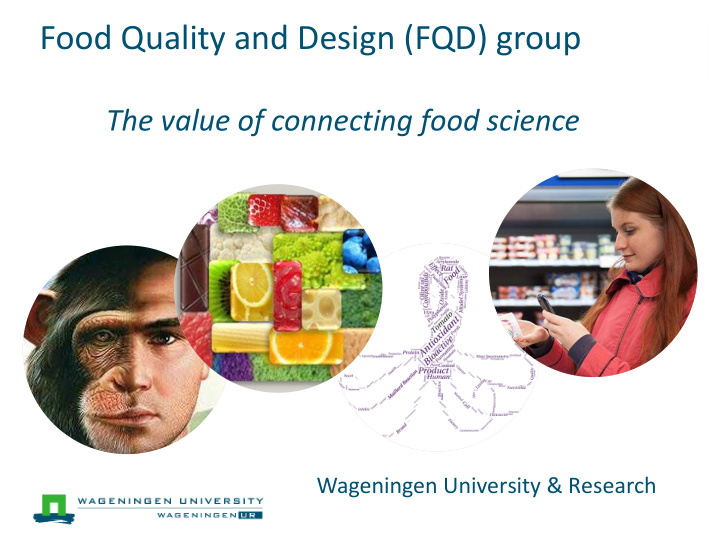



Food Quality and Design (FQD) group The value of connecting food science Wageningen University & Research
Food Quality and Design group (FQD) within Wageningen University Raoul Cluster Food Science and Technology Bino Food Food Food Food Food Food Food Quality Physics Process Chem istry Microbiology Physics Microbiology Engineering and Design FQD Harry Gruppen Eric van der Linden Vincenzo Fogliano Marcel Zwietering Remko Boom FBR Food Biobased Research (Applied Research Institute)
Food design: the chain approach Identification Processing physiological technology targets Raw material Formulation selection and Consumer improvement perception & behaviour
Monitoring arom a release of chew ing gum through Proton Transfer Reaction Mass Spectrom etry and sensory analysis PhD Michele Pedrotti MSc Andrea Spaccassassi
Experimental design Gum in triplicate. 30 panellists 15 Chinese, 15 European Each gum was masticated for 7 minutes. 15 male, 15 female Both PTR-MS and sensory Labelled magnitude scale was used to analysis were performed evaluate perception . simultaneously. Flavour intensity and sweetness perception were Physiological parameters were taken to explain variation among panellists evaluated at different time intervals during consumption •Salivary flow •Oral cavity volume •Papillary count
HOW DO WE DO THAT? PTR-MS in vivo, in- nose space analysis Panelists chew the gum and at the same time perform sensory analysis Dynamic Sensory evaluation of Flavour perception
Machine settings: a closer look at what’s going on in your nose The air coming out of Concentration the nose is of VOCs can continuously be followed sampled by throughout two heated the product (90°C) nose consumption. tubes.
Aim of the study? Dynamically investigate flavour release during chewing gum consumption Investigate the Clarify the variation in relation flavour release between and perception flavour among panellists perception (saliva, oral and flavour cavity, release background).
Maize volatile and consum er preference: a consum er driven approach to m aize breeding program in Africa PhD Onu Ekpa BSc Aniek de Vos
Background: Maize value chain Mostly neglected: The farther maize breeders deviate from preferred and accustomed sensory profile, the more difficult! 10
Research Objectives • Determine the volatile profiles of maize kernels of the commonly used varieties and their respective porridges. • Link back the differences in the volatiles to the consumers preferences by connecting research results and sensory tests. 11
Association of maize VOC and consumer perception Consumer Cluster of maize perception variety / VOC . Bland . Sweet . Bitter (Erasmus, et al., 2017) Figure 1: Association of maize VOC and consumer perception
I m pact of blueberry consum ption on volatile organic com pounds of hum an breath and saliva: a pilot study PhD Xianghui Kong
Sample Measured mass (m/z) Tentative identification BL INT CT p-Value 33.0338 Methanol 99.3 ± 9.1 b 163.9 ± 34.8 a 153.2 ± 25.7 a 0.030 47.0130 Formic acid 8.89 ± 0.23 a 5.79 ± 0.54 b 5.07 ± 0.53 b <10 -3 Saliva 59.0490 Acetone 297 ± 52.9 b 343 ± 70.3 b 775 ± 273.5 a 0.008 VOC 69.0703 Isoprene 4.35 ± 0.48 a 2.93 ± 0.33 b 2.93 ± 0.39 b 0.001 1.35 ± 0.16 a 0.87 ± 0.13 b 1.01 ± 0.17 ab 87.0813 Pentanal/ 3-methyl-3-buten-1-ol (t) 0.006 3.83 ± 1.32 a 1.02 ± 0.31 b 1.57 ± 0.74 b 103.0780 Ethyl propanoate/ Methyl isobutyrate (t) 0.005 31.0189 Formaldehyde 0.69 ± 0.06 b 1.17 ± 0.15 a 1.48 ± 0.25 a <10 -3 47.0143 Formic acid 5.21 ± 0.35 b 6.76 ± 0.55 a 6.67 ± 0.67 a 0.007 Breath 59.0475 Acetone 1497 ± 206 b 1439 ± 171 b 2896 ± 821 a 0.006 VOC 63.0279 Dimethyl sulphide 7.04 ± 0.79 b 12.63 ± 2.44 a 8.76 ± 1.28 ab 0.004 69.0713 Isoprene 91.1 ± 4.26 b 178 ± 31.7 a 181 ± 19.4 a <10 -3 87.0477 2,3-butanedione 1.32 ± 0.06 b 1.56 ± 0.09 ab 1.73 ± 0.18 a 0.004 Several significant differences after the week of blueberry consumption. • Inter-individual differences very high • Physiological meaning?
WUR FQD staff Anita Linnemann Geert Meijer Sine Yener Onu Ekpa Michele Pedrotti Franco Biasioli (FEM), Italy vincenzo.fogliano@wur.nl Thank you for your attention
Recommend
More recommend